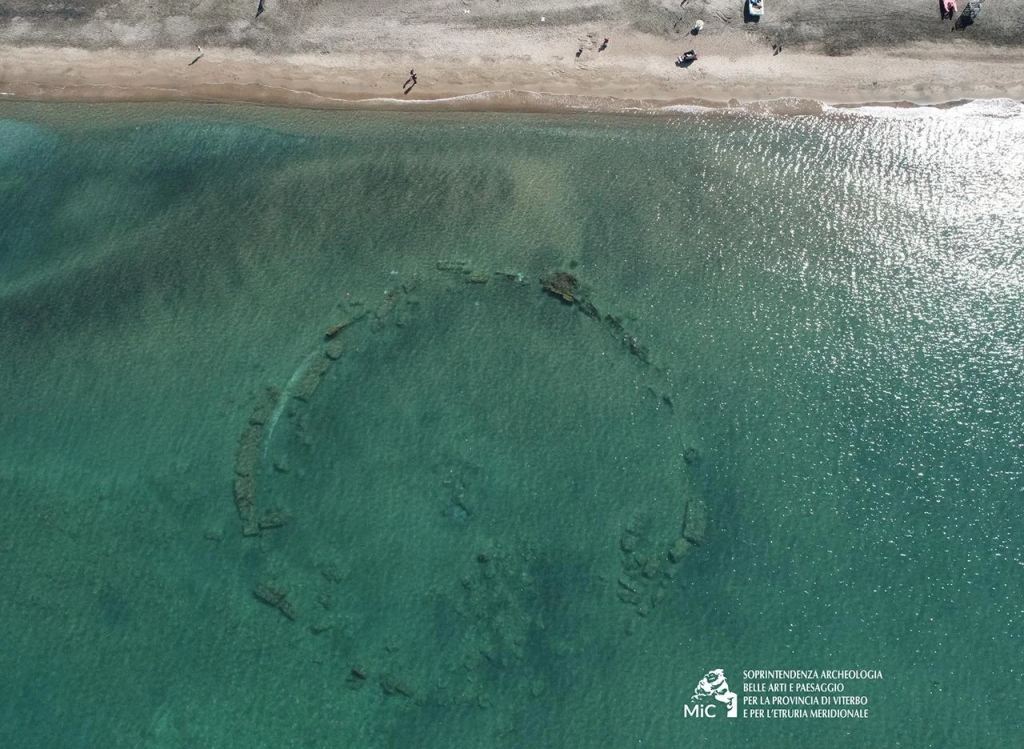
Archaeologists discover submerged Roman structure on Italy’s west coast
An important submerged Roman building has been uncovered on the coastline of Campo di Mare on Italy’s west coast.
The 50-meter-diameter circular Roman structure discovered underwater was connected to a Cipollino marble column with an Ionic capital in 2021.
Initial investigations by experts suggest that the extent and complexity of the structure could be a sea pavilion belonging to a Roman villa that has yet to be uncovered.

Located in Campo di Mare, this ancient site offers a fascinating glimpse into the luxurious lifestyles of the Roman aristocracy and the advanced construction techniques of the time.
According to Arkeonews, the Roman pavilion has a belt of double brick walls separated by about three meters and built on a layer of clay. This clay foundation preserved the wooden formwork and numerous foundation posts.

Photo: Soprintendenza Archeologia Belle Arti Paesaggio Etruria Meridionale
The walls, notable for their thickness, are built with a double layer of triangular bricks containing gravel and mortar, connected by two-foot bricks. This construction method reflects advanced engineering and resilience to the harsh marine environment.
The structure retains opus signinum coatings and opus spicatum coatings. Opus signinum was primarily used for its waterproofing properties in structures such as baths, aqueducts and cisterns. In the center, pieces of opus sectile flooring were found, indicating the opulence and elegance of the structure. Opus sectile is a decorative technique that uses cut and inlaid materials to create intricate designs often found in luxurious settings.

Photo: Soprintendenza Archeologia Belle Arti Paesaggio Etruria Meridionale
A press release from the Soprintendenza Archeologia Belle Arti Paesaggio Etruria Meridionale states that the architectural features of the mansion emphasize its importance in relation to Roman villa architecture. The widespread use of opus sectile and opus signinum and the presence of opus spicatum demonstrate the sophisticated construction methods and aesthetic sensibilities of the time.
The Underwater Archaeology Service of the Superintendency carried out the project, with support from the company CSR Restauro Beni Culturali for the cleaning and restoration of the structures.
Cover Photo: Soprintendenza Archeologia Belle Arti Paesaggio Etruria Meridionale
You may also like
- A 1700-year-old statue of Pan unearthed during the excavations at Polyeuktos in İstanbul
- The granary was found in the ancient city of Sebaste, founded by the first Roman emperor Augustus
- Donalar Kale Kapı Rock Tomb or Donalar Rock Tomb
- Theater emerges as works continue in ancient city of Perinthos
- Urartian King Argishti’s bronze shield revealed the name of an unknown country
- The religious center of Lycia, the ancient city of Letoon
- Who were the Luwians?
- A new study brings a fresh perspective on the Anatolian origin of the Indo-European languages
- Perhaps the oldest thermal treatment center in the world, which has been in continuous use for 2000 years -Basilica Therma Roman Bath or King’s Daughter-
- The largest synagogue of the ancient world, located in the ancient city of Sardis, is being restored











Leave a Reply